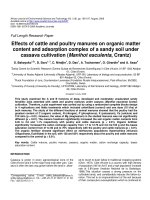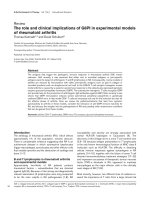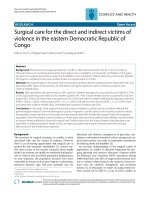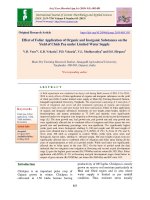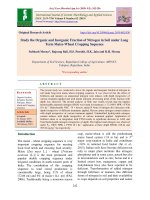Study the organic and inorganic fraction of nitrogen in soil under long term maize-wheat cropping sequence
Bạn đang xem bản rút gọn của tài liệu. Xem và tải ngay bản đầy đủ của tài liệu tại đây (488.11 KB, 15 trang )
Int.J.Curr.Microbiol.App.Sci (2019) 8(2): 242-256
International Journal of Current Microbiology and Applied Sciences
ISSN: 2319-7706 Volume 8 Number 02 (2019)
Journal homepage:
Original Research Article
/>
Study the Organic and Inorganic Fraction of Nitrogen in Soil under Long
Term Maize-Wheat Cropping Sequence
Subhash Meena*, Bajrang Bali, H.S. Purohit, H.K. Jain and R.H. Meena
Department of Soil Science, Rajasthan College of Agriculture, MPUAT,
Udaipur, Rajasthan, India
*Corresponding author
ABSTRACT
Keywords
Organic fraction,
Inorganic fraction,
Nitrogen, Maizewheat and Cropping
sequence
Article Info
Accepted:
04 January 2019
Available Online:
10 February 2019
The present study was conducted to know the organic and inorganic fraction of nitrogen in
soil under long term maize-wheat cropping sequence. It was observed that the effect of
fertilizers and manures on ammonical nitrogen were reduces with depth irrespective of
various treatment applied and with nitrate nitrogen, decreasing trend of this fraction with
depth was observed. The pooled analysis of both year results reveals that the highest
hydrolysable ammonia nitrogen (HAN) was found in treatment i.e. T9-100% NPK + FYM
10 t ha-1. Hydrolysable NH4+ –N + hexose amine-N form of nitrogen also decreases with
depth irrespective of different treatments applied. Hexose amine nitrogen content reduces
with depth irrespective of various treatment applied. Unidentified hydrolysable nitrogen
content reduces with depth irrespective of various treatment applied. Application of
fertilizer alone or in integration with FYM results in significant decrease in AAN and
Total hydrolysable nitrogen irrespective of depth. The highest total nitrogen was observed
under T9- 100% NPK + FYM 10 t ha-1 application at three depth 889.08, 818.44 and
705.54 mg kg-1 ha respectively.
crop, maize-wheat is still the predominant
maize based system (1.8 m ha) and is 3rd
major crop-rotation in India and contributes
~3.0% in national food basket (Jat et al.,
2013). Indian soils have become deficient not
only in major plant nutrients like nitrogen,
phosphorus and in some cases, potash but also
in micronutrients such as zinc, boron and to a
limited extent iron, manganese, copper and
molybdenum have also been reported to be
deficient. Transformation of added nitrogen
through fertilizers or manures into different
forms of nitrogen in soil and their availability
to crops depends on soil properties and nature
Introduction
The maize - wheat cropping sequence is very
important cropping sequence for meeting
local food needs and ensuring food security.
Maize [Zea mays L.] - wheat [Triticum
aestivum (L.)] is the most prominent and
popular double cropping sequence under
irrigated conditions in north-western parts of
India. The contribution of this cropping
sequence to total cereal production is
considerably large, being 31% of wheat
(72.06 mt) and 6% of maize (14.1 mt) (FAI,
2006). Traditionally being a monsoon season
242
Int.J.Curr.Microbiol.App.Sci (2019) 8(2): 242-256
of nitrogen sources added to soils. Nitrogen
dynamics related to its availability to plants is
always a subject of practical interest. In most
soils, N is mainly organic in nature, hence
normally only a small portion of total nitrogen
is present in an inorganic form which, except
in soils containing much fixed ammonium, is
easily available to plants (Stevenson, 1982)
With regard to its utilization 40-50 per cent of
applied nitrogen is utilized by crop, about 1525per cent is lost by different mechanisms
and 20-30per cent remains in the soil as the
fractions that are relatively inert and do not
contribute more than 3-5 per cent to the
succeeding crop.
Results and Discussion
The knowledge of distribution of various
forms of nitrogen in soil attains greater
importance in understanding the potential of a
soil in supplying them to the crops and also to
understand the nitrogen use efficiency by
crops. Hence, it becomes an essential part of
nitrogen management during the process of
crop production (Shilpa shree et al., 2012).
Inorganic fraction of nitrogen
Nutrients, both natives as well as applied
either through chemical fertilizers or by way
of organic amendments, undergo a series of
transformations due to continuous manuring
and cropping which, in turn, may have
substantial impact on their availability to
crops.
The results with respect to different fractions
of nitrogen in relation to long-term additions
of chemical fertilizers alone or in combination
with FYM under different treatments have
been presented below.
Ammonical nitrogen
Data pertaining to the effect of fertilizers and
manures on ammonical nitrogen were
presented in (Table 1). Application of
fertilizers alone or in combination with FYM
treatment resulted in a significant build up of
ammonical nitrogen over control.
Materials and Methods
The present study was conducted at the
Instructional farm, Rajasthan College of
Agriculture, Udaipur during 2015-16 and
2016-17.
Data presented shows that ammonical
nitrogen (NH4+- N) content of the soil after
harvest of maize- wheat crop varied from
13.09 to 19.87 mg kg-1 and 13.50 to 20.28 mg
kg-1 at 0-15 cm, 12.96 to 19.74 and 12.74 to
19.52 mg kg-1 at 15-30 cm and 12.15 to 18.93
and 11.75 to 18.55 mg kg-1 at 30-45 cm depth
during 2015-16 and 2016-17, respectively.
Application of 100% NPK + FYM 10 t ha-1
(T9) resulted higher content of NH4+- N at
three depths, during 2015-16 and 2016-17.
Pooled data also reveals that the highest
20.08, 19.63 and 18.74 mg kg-1 NH4+- N with
100% NPK + FYM 10 t ha-1 application at 015 cm, 15-30 cm and 30-45 cm as compared
to 13.29, 12.85 and 11.95 mg kg-1 under
control was obtained. Ammonical nitrogen
content reduces with depth irrespective of
various treatment applied.
Experimental soil
The long term fertilizer experiment was
initiated in 1996 - 97; the composite soil
sample was drawn from 0-15 cm depth prior
to treatment application in order to ascertain
initial fertility status and physico-chemical
properties of the experimental soil.
Experimental field was sandy clay loam in
texture, non-saline and slightly alkaline in
reaction. The macro and micronutrient
analysis revealed that soil was medium in N,
P, K, S and have sufficient level of DTPA
extractable Fe, Mn, Zn and Cu.
243
Int.J.Curr.Microbiol.App.Sci (2019) 8(2): 242-256
and 182.35 mg kg-1, 148.26 and 142.46 mg
kg-1 and 137.86 and 134.03 mg kg-1 at 0-15
cm, 15-30 cm and 30-45 cm depth was
recorded during 2015-16 and 2016-17
followed by 150% NPK (T11) with pooled
values 152.48, 137.68 and 132.73 mg kg-1 at
0-15 cm, 15-30 cm and 30-45 cm depth. This
form of nitrogen also decreases with depth
irrespective of different treatments applied
(Table 4).
Nitrate nitrogen
Nitrate nitrogen (NO3-- N) differed
significantly during both of years (Table 2).
Nitrate nitrogen content of the soil at 0-15 cm,
15-30 cm and 30-45 cm depth after harvest of
wheat crop varied from 4.55 to 7.05 mg kg-1,
4.52 to 7.02 mg kg-1 and 4.47 to 6.97 mg kg-1
in treatments, respectively during 2015-16
and 2016-17. The higher value was recorded
in T11-150% NPK at 0-15 cm (7.05 and 7.10
mg kg-1), at 15-30 cm (7.02 and 7.00 mg kg-1)
and at 30-45 cm (6.97 and 6.95 mg kg-1)
during 2015-16 and 2016-17, respectively,
followed by T6 (100% NPK+ S) with 6.96 and
7.01 mg kg-1 NO3-- N at 0-15 cm depth which
was at par with T11. The decreasing trend of
this fraction with depth was observed. Pooled
analysis also reveals the same pattern of the
nitrate nitrogen.
Hexoseamine nitrogen
Data presented in (Table 5) shows that
hexoseamine nitrogen (HSN) content of the
soil after harvest of maize- wheat crop varied
from 13.20 to 21.85 mg kg-1 and 13.30 to
24.15 mg kg-1 at 0-15 cm, 10.10 to 20.41 and
9.40 to 19.25 mg kg-1 at 15-30 cm and 8.30 to
17.36 and 7.50 to 16.89 mg kg-1 at 30-45 cm
depth during 2015-16 and 2016-17,
respectively. Application of 100% NPK +
FYM 10 t ha-1 (T9) resulted higher content of
HSN at three depths, during 2015-16 and
2016-17. Pooled data also reveals that the
highest 23.00, 19.83 and 17.13 mg kg-1 HSN
with 100% NPK + FYM 10 t ha-1 application
at 0-15 cm, 15-30 cm and 30-45 cm as
compared to 13.25, 9.75 and 7.90 mg kg-1
under control was obtained. Hexose amine
nitrogen content reduces with depth
irrespective of various treatment applied.
Organic fraction of nitrogen
Hydrolysable ammonia nitrogen
The pooled analysis of both year results
reveals that the highest hydrolysable ammonia
nitrogen(HAN) was found in treatment i.e.
T9-100%
NPK
+
FYM
10
t
ha-1.The highest values of HAN 149.65 and
158.20 mg kg-1, 127.85 and 123.21 mg kg-1
and 120.50 and 117.14 mg kg-1 at 0-15 cm,
15-30 cm and 30-45 cm depth was recorded
during 2015-16 and 2016-17, respectively
followed by 150% NPK (T11) with pooled
values 130.78, 120.88 and 118.03 mg kg-1 at
0-15 cm, 15-30 cm and 30-45 cm depth,
respectively. This form of nitrogen also
decreases with depth irrespective of different
treatments applied (Table 3).
Amino acid nitrogen
Amino acid nitrogen (AAN) varies from 99 to
161 mg kg-1, 87.15 to 154.15 mg kg-1and
82.35 to 152.76 mg kg-1and 79.95 to 150.36
mg kg-1and 78.25 to 148.66mg kg-1during
2015-16 and 2016-17 at 0-15, 15-30 and 3045 cm depth, respectively (Table 6). The
significantly higher value of AAN163.95,
153.46 and 149.51mg kg-1 in T9 treatment at
0-15 15-30 and 30-45 cm depth and it is
closely followed by T11- 150% NPK and T8(100% NPK + Azotobacter) treatments.
Hydrolysable NH4+ –N + hexoseamine-N
The higher pooled value was recorded under
application of 100% NPK + FYM 10 t ha-1
(T9) followed by T11 -150% NPK. The highest
values of NH4+ –N + hexoseamine-N171.50
244
Int.J.Curr.Microbiol.App.Sci (2019) 8(2): 242-256
Table.1 Effect of fertilizers and manures on ammonical nitrogen (mg kg-1) in soil under maize–wheat cropping sequence at different
depth
Treatments
T1 = Control
T2 = 100% N
T3 = 100% NP
T4 = 100% NPK
T5 = 100% NPK + Zn
T6 = 100% NPK+ S
T7 = 100% NPK+ Zn + S
T8 = 100% NPK + Azotobactor
T9 = 100% NPK + FYM 10 t ha-1
T10 = FYM 10 t ha-1 + 100% NPK (-NPK of
FYM)
T11 = 150% NPK
T12 = FYM 20 t ha-1
S.Em.±
C.D. (P = 0.05)
2015-16
13.09
13.80
17.51
18.89
16.84
14.79
16.12
17.64
19.87
13.36
0-15 cm
2016-17
13.50
14.21
17.92
19.30
17.25
15.20
16.53
18.05
20.28
13.77
19.25
14.87
0.37
1.06
19.66
15.28
0.38
1.09
Ammonical nitrogen (NH4+- N)
15-30 cm
30-45 cm
Pooled 2015-16 2016-17 Pooled 2015-16 2016-17
13.29
12.96
12.74
12.85
12.15
11.75
14.01
13.67
13.45
13.56
12.86
12.48
17.71
17.38
17.16
17.27
16.57
16.19
19.10
18.76
18.54
18.65
17.95
17.57
17.04
16.71
16.49
16.60
15.90
15.52
14.99
14.66
14.44
14.55
13.85
13.47
16.33
15.99
15.77
15.88
15.18
14.80
17.85
17.51
17.29
17.40
16.70
16.30
20.08
19.74
19.52
19.63
18.93
18.55
13.56
13.23
13.01
13.12
12.42
12.04
19.45
15.08
0.26
0.74
245
19.12
14.74
0.36
1.05
18.90
14.52
0.36
1.04
19.01
14.63
0.25
0.72
18.31
13.93
0.34
1.00
17.93
13.54
0.33
0.97
Pooled
11.95
12.67
16.38
17.76
15.71
13.66
14.99
16.50
18.74
12.23
18.12
13.74
0.24
0.68
Int.J.Curr.Microbiol.App.Sci (2019) 8(2): 242-256
Table.2 Effect of fertilizers and manures on nitrate nitrogen (mg kg-1) in soil under maize –wheat cropping sequence at different depth
Treatments
T1 = Control
T2 = 100% N
T3 = 100% NP
T4 = 100% NPK
T5 = 100% NPK + Zn
T6 = 100% NPK+ S
T7 = 100% NPK+ Zn + S
T8 = 100% NPK + Azotobactor
T9 = 100% NPK + FYM 10 t ha-1
T10 = FYM 10 t ha-1 + 100% NPK (-NPK of FYM)
T11 = 150% NPK
T12 = FYM 20 t ha-1
S.Em.±
C.D. (P = 0.05)
2015-16
4.554
5.759
6.295
6.563
6.741
6.964
6.920
6.518
6.920
5.893
7.054
6.384
0.142
0.409
0-15 cm
2016-17
4.604
5.809
6.345
6.613
6.791
7.014
6.970
6.568
6.970
5.943
7.104
6.434
0.143
0.412
Pooled
4.579
5.784
6.320
6.588
6.766
6.989
6.945
6.543
6.945
5.918
7.079
6.409
0.101
0.285
246
Nitrate Nitrogen (NO3—N)
15-30 cm
2015-16 2016-17 Pooled
4.524
4.504
4.514
5.729
5.709
5.719
6.265
6.245
6.255
6.533
6.513
6.523
6.711
6.691
6.701
6.934
6.914
6.924
6.890
6.870
6.880
6.488
6.468
6.478
6.890
6.870
6.880
5.863
5.843
5.853
7.024
7.004
7.014
6.354
6.334
6.344
0.141
0.141
0.099
0.407
0.405
0.282
2015-16
4.474
5.679
6.215
6.483
6.661
6.884
6.840
6.438
6.840
5.813
6.974
6.304
0.140
0.403
30-45 cm
2016-17
4.453
5.658
6.194
6.462
6.640
6.863
6.759
6.417
6.809
5.782
6.953
6.283
0.139
0.402
Pooled
4.463
5.668
6.204
6.472
6.650
6.874
6.799
6.427
6.824
5.797
6.963
6.293
0.099
0.279
Int.J.Curr.Microbiol.App.Sci (2019) 8(2): 242-256
Table.3 Effect of fertilizers and manures on hydrolysable ammonia nitrogen (mg kg-1) in soil under maize –wheat cropping sequence
at different depth
Treatments
Hydrolysable Ammonia Nitrogen (HAN)
15-30 cm
Pooled
20152016Pooled
201516
17
16
105.28
92.20
87.56
89.88
78.26
120.53 108.95 105.31 107.13
99.05
124.18 112.10 111.46 111.78 101.45
125.83 118.75 117.11 117.93 110.50
124.22 116.15 112.51 114.33 108.34
123.63 115.55 112.91 114.23 110.02
124.80 119.20 115.56 117.38 107.60
125.03 112.45 110.81 111.63 106.04
153.93 127.85 123.21 125.53 120.50
201516
105.00
119.75
122.90
123.55
123.95
123.35
124.00
124.25
149.65
0-15 cm
201617
105.55
121.30
125.45
128.10
124.50
123.90
125.60
125.80
158.20
T10 = FYM 10 t ha-1 + 100% NPK (-NPK of
FYM)
110.50
113.05
111.78
108.70
106.06
107.38
T11 = 150% NPK
T12 = FYM 20 t ha-1
S.Em.±
C.D. (P = 0.05)
130.00
121.50
2.82
8.11
131.55
126.05
2.86
8.25
130.78
123.78
2.01
5.68
121.20
119.70
2.62
7.54
120.56
116.06
2.55
7.33
120.88
117.88
1.82
5.16
T1 = Control
T2 = 100% N
T3 = 100% NP
T4 = 100% NPK
T5 = 100% NPK + Zn
T6 = 100% NPK+ S
T7 = 100% NPK+ Zn + S
T8 = 100% NPK + Azotobactor
T9 = 100% NPK + FYM 10 t ha-1
247
30-45 cm
2016-17
Pooled
75.43
97.29
98.46
108.09
102.50
104.80
105.54
101.75
117.14
76.85
98.17
99.96
109.30
105.42
107.41
106.57
103.90
118.82
102.39
99.04
100.72
118.53
115.02
2.41
6.95
117.52
113.05
2.34
6.74
118.03
114.04
1.68
4.75
Int.J.Curr.Microbiol.App.Sci (2019) 8(2): 242-256
Table.4 Effect of fertilizers and manures on hydrolysable NH4+ –N + hexoseamine-N (mg kg-1) in soil under maize –wheat cropping
sequence at different depth
Treatments
T1 = Control
T2 = 100% N
T3 = 100% NP
T4 = 100% NPK
T5 = 100% NPK + Zn
T6 = 100% NPK+ S
T7 = 100% NPK+ Zn + S
T8 = 100% NPK + Azotobactor
T9 = 100% NPK + FYM 10 t ha-1
T10 = FYM 10 t ha-1 + 100% NPK (-NPK of FYM)
T11 = 150% NPK
T12 = FYM 20 t ha-1
S.Em.±
C.D. (P = 0.05)
2015-16
118.20
135.85
139.50
141.40
141.25
141.35
143.50
143.50
171.50
128.50
150.50
137.50
3.23
9.30
0-15 cm
2016-17
118.85
142.50
146.15
152.05
141.90
142.00
144.25
150.15
182.35
136.15
154.45
141.15
3.35
9.65
Hydrolysable NH4 –N + Hexoseamine-N
15-30 cm
Pooled 2015-16 2016-17 Pooled 2015-16
118.53
102.30
96.96
99.63
86.56
139.18
120.95
116.89
118.92
109.25
142.83
125.62
124.54
125.08
113.79
146.73
128.86
127.13
128.00
119.71
141.57
126.92
122.78
124.85
117.42
141.68
127.45
124.29
125.87
120.30
143.88
129.58
125.88
127.73
117.49
146.83
130.44
127.91
129.18
122.61
176.93
148.26
142.46
145.36
137.86
132.33
121.35
118.18
119.77
113.68
152.48
138.50
136.86
137.68
133.73
139.33
134.60
130.52
132.56
129.08
2.32
2.93
2.84
2.04
2.69
6.57
8.45
8.19
5.77
7.74
248
30-45 cm
2016-17
82.93
107.29
109.91
117.15
111.28
114.45
114.75
117.18
134.03
109.40
131.72
126.49
2.60
7.48
Pooled
84.75
108.27
111.85
118.43
114.35
117.38
116.12
119.90
135.95
111.54
132.73
127.79
1.87
5.28
Int.J.Curr.Microbiol.App.Sci (2019) 8(2): 242-256
Table.5 Effect of fertilizers and manures on hexoseamine nitrogen (mg kg-1) in soil under maize –wheat cropping sequence at
different depth
Treatments
Hexoseamine Nitrogen (HSN)
15-30 cm
2015-16 2016-17 Pooled 2015-16
10.10
9.40
9.75
8.30
12.00
11.58
11.79
10.20
2015-16
13.20
16.10
0-15 cm
2016-17
13.30
21.20
Pooled
13.25
18.65
T3 = 100% NP
T4 = 100% NPK
T5 = 100% NPK + Zn
16.60
17.85
17.30
20.70
23.95
17.40
18.65
20.90
17.35
13.52
10.11
10.77
13.08
10.02
10.27
13.30
10.07
10.52
T6 = 100% NPK+ S
18.00
18.10
18.05
11.90
11.38
T7 = 100% NPK+ Zn + S
T8 = 100% NPK + Azotobactor
19.50
19.25
18.65
24.35
19.08
21.80
10.38
17.99
T9 = 100% NPK + FYM 10 t ha-1
21.85
24.15
23.00
T10 = FYM 10 t ha + 100% NPK (-NPK of FYM)
18.00
23.10
T11 = 150% NPK
T12 = FYM 20 t ha-1
20.50
16.00
S.Em.±
C.D. (P = 0.05)
T1 = Control
T2 = 100% N
-1
30-45 cm
2016-17
7.50
10.00
Pooled
7.90
10.10
12.34
9.21
9.08
11.45
9.06
8.78
11.90
9.14
8.93
11.64
10.28
9.65
9.97
10.32
17.10
10.35
17.55
9.89
16.57
9.21
15.43
9.55
16.00
20.41
19.25
19.83
17.36
16.89
17.13
20.55
12.65
12.12
12.39
11.29
10.36
10.83
22.90
15.10
21.70
15.55
17.30
14.90
16.30
14.46
16.80
14.68
15.20
14.06
14.20
13.44
14.70
13.75
0.41
0.52
0.33
0.31
0.30
0.21
0.27
0.25
0.19
1.19
1.50
0.94
0.91
0.86
0.61
0.80
0.74
0.53
249
Int.J.Curr.Microbiol.App.Sci (2019) 8(2): 242-256
Table.6 Effect of fertilizers and manures on amino acid nitrogen (mg kg-1) in soil under maize –wheat cropping sequence at different
depth
Treatments
T1 = Control
2015-16
99.00
0-15 cm
2016-17
99.25
Pooled
99.13
Amino Acid Nitrogen (AAN)
15-30 cm
2015-16 2016-17 Pooled 2015-16
87.15
82.35
84.75
79.95
T2 = 100% N
122.50
126.15
124.33
118.65
116.58
117.62
T3 = 100% NP
T4 = 100% NPK
T5 = 100% NPK + Zn
T6 = 100% NPK+ S
T7 = 100% NPK+ Zn + S
T8 = 100% NPK + Azotobactor
T9 = 100% NPK + FYM 10 t ha-1
128.00
132.00
132.50
132.50
133.50
134.00
161.00
128.37
138.58
133.15
134.59
133.78
135.50
166.89
128.19
135.29
132.82
133.55
133.64
134.75
163.95
122.15
128.10
126.64
128.65
127.40
130.25
154.15
121.39
128.00
124.30
125.50
122.89
129.00
152.76
T10 = FYM 10 t ha-1 + 100% NPK (-NPK of FYM)
133.00
136.50
134.75
129.34
T11 = 150% NPK
146.50
152.75
149.63
128.50
133.85
S.Em.±
3.06
C.D. (P = 0.05)
8.80
T12 = FYM 20 t ha
-1
30-45 cm
2016-17
78.25
Pooled
79.10
114.18
112.48
113.33
121.77
128.05
125.47
127.08
125.15
129.63
153.46
118.99
125.60
121.90
123.10
120.49
126.60
150.36
117.29
123.90
120.20
121.40
118.79
124.90
148.66
118.14
124.75
121.05
122.25
119.64
125.75
149.51
128.34
128.84
125.94
124.24
125.09
140.55
137.27
138.91
134.87
133.17
134.02
131.18
123.65
123.55
123.60
121.15
119.45
120.30
3.12
2.18
2.91
2.85
2.04
2.80
2.76
1.96
8.99
6.17
8.38
8.22
5.76
8.06
7.94
5.55
250
Int.J.Curr.Microbiol.App.Sci (2019) 8(2): 242-256
Table.7 Effect of fertilizers and manures on unidentified hydrolysable nitrogen (mg kg-1) in soil under maize –wheat cropping
sequence at different depth
Treatments
Unidentified Hydrolysable Nitrogen (UHN)
15-30 cm
Pooled 2015-16 2016-17 Pooled 2015-16
196.55
180.77
176.50
178.64
170.22
T1 = Control
2015-16
196.30
0-15 cm
2016-17
196.80
T2 = 100% N
224.45
224.80
224.63
211.92
207.90
209.91
202.50
200.64
201.57
T3 = 100% NP
T4 = 100% NPK
T5 = 100% NPK + Zn
T6 = 100% NPK+ S
T7 = 100% NPK+ Zn + S
T8 = 100% NPK + Azotobactor
T9 = 100% NPK + FYM 10 t ha-1
243.00
261.60
264.24
266.15
264.50
263.50
277.50
243.58
266.96
264.77
266.11
264.91
264.18
282.83
243.29
264.28
264.51
266.13
264.71
263.84
280.17
230.47
249.05
251.61
253.60
251.57
250.38
264.50
226.45
244.03
245.60
248.43
247.95
247.01
260.65
228.46
246.54
248.61
251.02
249.76
248.70
262.58
218.65
240.48
240.89
242.35
244.08
245.04
258.59
215.31
238.68
236.56
239.50
240.20
241.24
254.58
216.98
239.58
238.72
240.93
242.14
243.14
256.59
T10 = FYM 10 t ha-1 + 100% NPK (-NPK of FYM)
284.00
284.60
284.30
271.45
267.45
269.45
259.80
250.42
255.11
T11 = 150% NPK
273.80
274.30
274.05
261.26
257.25
259.26
251.20
248.00
249.60
T12 = FYM 20 t ha-1
249.00
252.65
250.83
236.45
232.43
234.44
229.00
227.89
228.45
S.Em.±
6.13
6.15
4.34
5.81
5.71
4.07
5.56
5.44
3.89
C.D. (P = 0.05)
17.66
17.71
12.27
16.73
16.44
11.51
16.01
15.65
10.98
251
30-45 cm
2016-17
168.43
Pooled
169.33
Int.J.Curr.Microbiol.App.Sci (2019) 8(2): 242-256
Table.8 Effect of fertilizers and manures on total hydrolysable nitrogen (mg kg-1) in soil under maize –wheat cropping sequence at
different depth
Treatments
Total Hydrolysable Nitrogen (THN)
15-30 cm
Pooled 2015-16 2016-17 Pooled 2015-16
414.20
370.22
350.81
360.52
335.98
T1 = Control
2015-16
413.50
0-15 cm
2016-17
414.90
T2 = 100% N
482.80
493.45
488.13
451.52
441.37
446.45
427.33
315.10
371.22
T3 = 100% NP
T4 = 100% NPK
T5 = 100% NPK + Zn
T6 = 100% NPK+ S
T7 = 100% NPK+ Zn + S
T8 = 100% NPK + Azotobactor
T9 = 100% NPK + FYM 10 t ha-1
510.50
535.00
537.99
540.00
541.50
541.00
610.00
518.10
557.59
539.82
542.70
542.94
549.83
632.07
514.30
546.30
538.90
541.35
542.22
545.42
621.04
478.24
506.01
505.17
509.70
508.55
511.07
566.91
472.38
499.16
492.67
498.22
496.72
503.92
555.87
475.31
502.59
498.92
503.96
502.64
507.50
561.39
452.00
487.27
481.77
486.15
480.35
494.14
546.70
334.52
363.76
356.92
359.17
355.14
363.02
403.23
393.26
425.52
419.35
422.66
417.75
428.58
474.97
T10 = FYM 10 t ha-1 + 100% NPK (-NPK of FYM)
545.50
557.25
551.38
522.14
513.97
518.06
501.50
377.66
439.58
T11 = 150% NPK
570.80
581.50
576.15
540.31
531.38
535.85
520.18
378.75
449.47
T12 = FYM 20 t ha-1
515.00
527.65
521.33
494.70
486.50
490.60
481.09
350.47
415.78
S.Em.±
12.41
12.62
8.85
11.65
11.38
8.14
11.07
8.19
6.88
C.D. (P = 0.05)
35.71
36.31
24.99
33.53
32.75
22.99
31.85
23.56
19.44
252
30-45 cm
2016-17
240.93
Pooled
288.46
Int.J.Curr.Microbiol.App.Sci (2019) 8(2): 242-256
Table.9 Effect of fertilizers and manures on non-hydrolysable nitrogen (mg kg-1) in soil under maize –wheat cropping sequence at
different depth
Treatments
Non-Hydrolysable Nitrogen (NHN)
15-30 cm
Pooled 2015-16 2016-17 Pooled 2015-16
121.22
109.30
108.17
108.74
99.08
T1 = Control
2015-16
121.00
0-15 cm
2016-17
121.43
T2 = 100% N
150.68
151.11
150.90
142.98
137.85
140.42
135.75
133.64
134.70
T3 = 100% NP
T4 = 100% NPK
T5 = 100% NPK + Zn
T6 = 100% NPK+ S
T7 = 100% NPK+ Zn + S
T8 = 100% NPK + Azotobactor
T9 = 100% NPK + FYM 10 t ha-1
159.14
187.50
148.16
209.10
173.48
150.96
240.8
159.57
187.93
148.59
209.53
173.91
151.39
241.23
159.36
187.72
148.37
209.32
173.70
151.18
241.02
151.44
179.80
140.46
201.40
165.78
143.26
233.10
146.31
174.67
135.33
196.27
160.65
138.13
227.97
148.88
177.24
137.89
198.84
163.22
140.70
230.54
142.50
172.59
133.00
186.26
157.42
135.08
222.14
139.48
160.50
128.21
175.26
119.00
131.08
187.87
140.99
166.55
130.60
180.76
138.21
133.08
205.01
T10 = FYM 10 t ha-1 + 100% NPK (-NPK of FYM)
144.23
144.66
144.45
136.53
131.4
133.97
129.23
127.49
128.36
T11 = 150% NPK
210.98
211.41
211.20
203.28
198.15
200.72
191.25
154.62
172.94
T12 = FYM 20 t ha-1
219.37
219.80
219.59
211.67
206.54
209.11
205.07
172.45
188.76
S.Em.±
3.76
3.77
2.66
3.55
3.45
2.47
3.34
3.13
2.29
C.D. (P = 0.05)
10.81
10.84
7.51
10.22
9.93
6.99
9.60
9.01
6.46
253
30-45 cm
2016-17
97.45
Pooled
98.27
Int.J.Curr.Microbiol.App.Sci (2019) 8(2): 242-256
Table.10 Effect of fertilizers and manures on total nitrogen (mg kg-1) in soil under maize –wheat cropping sequence at different depth
Treatments
T1 = Control
2015-16
552.15
0-15 cm
2016-17
554.44
Pooled
553.29
Total Nitrogen (TN)
15-30 cm
2015-16 2016-17 Pooled
497.01
476.23
486.62
T2 = 100% N
T3 = 100% NP
653.05
693.45
664.14
701.94
658.59
697.69
613.46
653.33
597.94
642.10
T4 = 100% NPK
T5 = 100% NPK + Zn
T6 = 100% NPK+ S
T7 = 100% NPK+ Zn + S
T8 = 100% NPK + Azotobactor
T9 = 100% NPK + FYM 10 t ha-1
747.96
709.74
770.85
738.03
716.13
877.60
771.44
712.46
774.44
740.36
722.01
900.56
759.70
711.09
772.65
739.19
719.07
889.08
711.11
669.06
732.69
697.22
674.50
826.65
T10 = FYM 10 t ha-1 + 100% NPK (-NPK of FYM)
708.98
725.91
717.45
T11 = 150% NPK
808.09
819.68
T12 = FYM 20 t ha-1
755.63
S.Em.±
C.D. (P = 0.05)
16.64
47.89
2015-16
451.69
30-45 cm
2016-17
354.58
Pooled
403.13
605.70
647.71
581.18
617.29
466.44
496.39
523.81
556.84
698.89
651.19
715.84
680.02
661.98
810.24
705.00
660.12
724.27
688.62
668.24
818.44
684.30
637.34
693.14
659.80
648.53
794.62
548.30
507.30
554.76
495.71
513.00
616.47
616.30
572.31
623.95
577.75
580.77
705.54
682.05
668.51
675.28
653.25
527.23
590.24
813.89
769.74
755.44
762.59
736.72
558.26
647.49
769.17
762.40
727.47
713.90
720.69
706.40
542.74
624.57
16.90
48.64
11.86
33.49
15.70
45.17
15.32
44.08
10.96
30.97
14.88
42.82
11.80
33.96
9.49
26.82
254
Int.J.Curr.Microbiol.App.Sci (2019) 8(2): 242-256
These treatments were found statistically at
par and superior than rest of treatments.
Application of fertilizer alone or in
integration with FYM results in significant
decrease in AAN irrespective of depth.
Non-hydrolysable nitrogen
Pooled over the year result was significant in
non-hydrolysable nitrogen (Table 9). The
significant higher pooled value 241.02,230.54
and 205.01 mg kg-1 was recorded by application
of 100% NPK + FYM 10 t ha-1 (T9) to maize –
wheat crops followed by 219.59,209.11 and
188.76 mg kg-1 in T12 and 211.20,200.72 and
172.94 mg kg-1 under T11 treatment at 0-15cm,
15-30 cm and 30-45 cm depth, respectively.
Similar trend was observed in both years. Higher
values of NHN was 240.80 and 241.23 mg kg-1
in surface soil (0-15 cm) 222.14 and 187.87 mg
kg-1 in sub surface soil (15-30 cm and 30-45 cm)
during 2015-16 and 2016-17 respectively with
application of 100% NPK + FYM 10 t ha-1
treatment.
Unidentified hydrolysable nitrogen
Results
indicates
that
unidentified
hydrolysable nitrogen (UHN) content
significantly influenced application of
fertilizer alone or in integration with FYM
treatments during both years at 0-15 15-30
and 30-45 cm depth (Table 7). The highest
UHN 284.30, 269.45 and 255.11 mg kg-1 was
observed at 0-15, 15-30 and 30-45 cm depth
by applying T10 - FYM 10 t ha-1 + 100% NPK
(-NPK of FYM) followed by 280.17, 262.58
and 256.59 mg kg-1 respectively with T9
treatment application. These both treatments
were at par and significantly superior to other
treatments.
Unidentified
hydrolysable
nitrogen content reduces with depth
irrespective of various treatment applied.
Total nitrogen
Total nitrogen content ranged from 553.29 to
889.08 mg kg-1, 486.62 to 818.44 mg kg-1 and
403.13 to 705.54 mg kg-1 at 0-15, 15-30 and
30- 45 cm depths (Table 10). The highest total
nitrogen was observed under T9- 100% NPK
+ FYM 10 t ha-1 application at three depth
889.08, 818.44 and 705.54 mg kg-1,
respectively followed by T11 - 150% NPK and
FYM 20 t ha-1(T12) treatment. Similar trend
was observed in both years. The significant
difference under these treatment plots result
of continuous application of fertilizers from
last 20 year in this cropping system
experiment. It is also evident from the data
that total nitrogen fraction is more at surface
soil (0-15 cm) than the subsurface soil (15-30
cm and 30-45 cm depth) irrespective
application of fertilizer alone or with
combination of FYM. As well as total
nitrogen contain ammonical-N (3.10%),
nitrate-N (0.87%), hydrolysable ammonia-N
(16.99%), hydrolysable NH4+ –N +
hexoseamine-N (19.58%), hexoseamine-N
(2.60%), amino acid-N (18.21%), unidentified
hydrolysable-N (34.15%), total hydrolysable-
Total hydrolysable nitrogen
Total hydrolysable nitrogen (THN) fraction
varies from 414.20 to 621.04 mg kg-1, 360.52
to 561.39 mg kg-1 and 288.46 to 474.97 mg
kg-1 at 0-15 15-30 and 30-45 cm depth under
pooled analysis (Table 8). The highest 610
and 632.07 mg kg-1566.91 and 555.87 mg kg-1
and546.70 and 403.23 mg kg-1 THN was
observed at 0-15, 15-30 and 30-45 cm depth,
during 2015-16 and 2016-17 respectively, at
T9 i.e. 100% NPK + FYM 10 t ha-1
application.
This treatment is closely followed by (150%
NPK) T11 treatment application. These
treatments were found statistically at par and
superior than rest of treatments. Application
of fertilizer alone or in integration with FYM
results in significant decrease in Total
hydrolysable nitrogen irrespective of depth.
255
Int.J.Curr.Microbiol.App.Sci (2019) 8(2): 242-256
N
(71.94%)
and
non-hydrolysable-N
(24.08%) in the soil under maize-wheat
cropping sequence.
metribuzin on nitrogen transformation.
Journal of the Indian Society of Soil
Science, 53(2): 184-187.
FAI 2006. Fertilizer Statistics, 2005-06. The
Fertilizer Association of India, New
Delhi.
Jat, M.L., Satyanarayana, T., Majumdar, K.,
Tetarwal, J.P., Jat, R.K. and Sharawat,
Y.S. 2013. Fertilizer based management
practices for maize systems. Indian
Journal of Fertilizer, 9:80-94.
Shilpashree, V.M., Chidanandappa, H.M.,
Jayaprakash, R. and Punitha, B.C. 2012.
Effect
of
integrated
nutrient
management practices on distribution of
nitrogen fractions by maize crop in soil.
Indian Journal of Fundamental and
Applied Life Sciences, 2(1): 38-44.
Stevenson, F.J. 1982. Organic forms of soil
nitrogen. In “Nitrogen in agricultural
soils. Soil Science Society of America,
Madison WI. Pp. 67-122.
References
Butter, G.S., Thind, H.S., Saroa, G.S. and
Grover, K. 2009. Performance of wheat
(Triticum aestivum) as influenced by N
fertilization in cluster bean (Cyamopsis
teragonoloba)–
wheat
(Triticum
aestivum) system. Indian Journal of
Agricultural Sciences, 79: 302-304.
Channabasavanna, A.S., Nagappa and
Biradar, D.P. 2007. Effect of Integrated
nutrient management on Productivity,
profitability, and sustainability of
irrigated maize. Karnataka Journal of
Agricultural Sciences, 20: 837-839.
Duhan, B.S., Kataria, D., Singh, J.P., Kuhad,
M.S. and Dahiya, S.S. 2005. Effect of
nitrogen,
farmyard
manure
and
How to cite this article:
Subhash Meena, Bajrang Bali, H.S. Purohit, H.K. Jain and Meena, R.H. 2019. Study the
Organic and Inorganic Fraction of Nitrogen in Soil under Long Term Maize-Wheat Cropping
Sequence. Int.J.Curr.Microbiol.App.Sci. 8(02): 242-256.
doi: />
256


